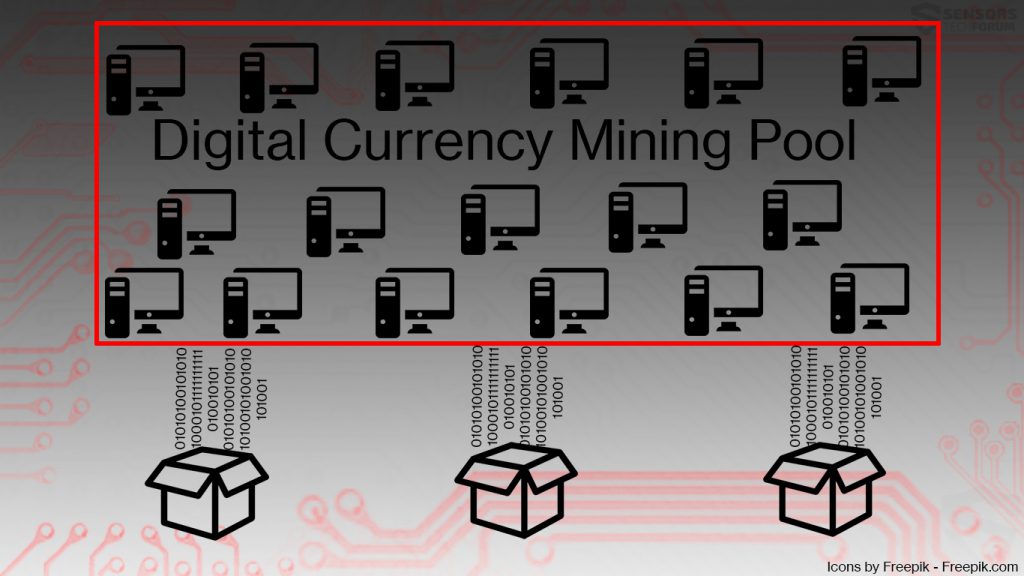 This article has been created in order to explain what is websock.exe malware process and how to remove the websock.exe cryptocurrency miner malware from your computer.
This article has been created in order to explain what is websock.exe malware process and how to remove the websock.exe cryptocurrency miner malware from your computer.
Miner viruses such as the Bitcoin minining virus have continued to gain popularity with the emergence of cryptocurrencies. New and new viruses, like the websock.exe miner have appeared and aim to use the resources of victim computers in order to generate cryptocurrency tokens for anonymous currencies, such as BitCoin or Monero. This activity results in your computer starting to slow down, experience system freezes and if the websock.exe miner remains on it for longer periods of time, the malware may begin to break it’s components due to using them at their limit all the time. In the event that you see the websock.exe miner malware being active on your computer system, recommendations are to read this article and learn how to remove the websock.exe cryptocurrency miner from your computer permanently.

Threat Summary
| Name | websock.exe Miner |
| Type | CryptoCurrency Miner |
| Short Description | Websock.exe has the purpose to infect your computer and use it’s resources to turn it into a miner for cryptocurrencies. |
| Symptoms | Hightened CPU and GPU usage and overheating. The victim PC may break if this virus mines for longer periods of time. |
| Distribution Method | Spam Emails, Email Attachments, Executable files |
| Detection Tool |
See If Your System Has Been Affected by malware
Download
Malware Removal Tool
|
User Experience | Join Our Forum to Discuss websock.exe Miner. |

Websock.exe – How Did I Get It
The primary method which is used by the Websock.exe malware is to slither it onto your computer system via getting you to open a malicious e-mail attachment. Such spammed e-mail messages often pretend to be legitimate as they usually deceive the victim to open their attachment by pretending it is a:
- Fake invoice.
- Receipt.
- Order confirmation.
In reality however, the attachment carries a malicious file which is obfuscated and triggers the initial infection by executing scripts that download the payload of websock.exe malware and execute it on the computer of the victim.
In addition to via e-mail, your computer may also become infected with the websock.exe miner malware by simply getting you to visit a suspicious website or trick you into downloading fake setup files, key generators or software activators from such sites, believing they are legitimate.

Websock.exe – More Information and Activity
When an infection by the websock.exe cryptocurrency miner takes place on your computer system, the virus may perform a series of activities on your computer, the first of which is to connect to a remove command and control (C&C) server or a distribution website and from there download the payload files, which may be of different types. The files may be located in the following Windows system folders under various names, for examle:
From there, the websock.exe cryptocurrency miner malware, may perform another malicious activity, which involves interfering with the registry entries. The virus may add registry value strings with data in them to make it so that the websock.exe miner file runs automatically on system start. The targeted registry sub-keys for this purpose are the following:
→ HKEY_LOCAL_MACHINE\Software\Microsoft\Windows\CurrentVersion\Run
HKEY_CURRENT_USER\Software\Microsoft\Windows\CurrentVersion\Run
HKEY_LOCAL_MACHINE\Software\Microsoft\Windows\CurrentVersion\RunOnce
HKEY_CURRENT_USER\Software\Microsoft\Windows\CurrentVersion\RunOnce
Once the cryptocurrency miner process websock.exe runs on your computer, it is pre-configured to connect you most likely to a mining pool, but directly link your computer to the wallet of the cyber-criminal. This scheme often works, because more computers linked to the same cryptocurrency wallet means more hashing power and more cryptocurrency tokens to be generated for shorter periods of time. If we put it simply here is how a mining pool operation works:
After this has been completed, the malware may begin to perform various other activities, most of which include the usage of different modules to self-update itself and migrate it’s processes to remain undetected for longer periods of time on your PC. In addition to this, the websock.exe malware may also have other Trojan capabilities, like the following:
- Steal your files.
- Obtain your passwords and login ID’s.
- Obtain your financial information.
- Log your keystrokes.
- Take screenshots.
- Download other malware on your computer.

Websock.exe Miner – How to Detect and Remove It
The websock.exe miner malware can be detected if you see the process websock.exe itself running in the background on your Task Manager and taking a lot of your CPU and GPU power. If you experience this, it is likely that the temperature of the components will rise as well, causing the fans of your PC to run at higher speed.
If you experience those symptoms and you see the websock.exe process running in the background of your computer, it is strongly recommended to follow the removal instructions down below. They are specifically designed to assist you with removing websock.exe either manually or automatically. Although manual removal is doable, security experts recommend to remove the websock.exe miner malware automatically by downloading an advanced anti-malware software, which will ensure that this miner malware and other viruses that may reside on your PC are gone and you stay protected against future infections as well.
Preparation before removing websock.exe Miner.
Before starting the actual removal process, we recommend that you do the following preparation steps.
- Make sure you have these instructions always open and in front of your eyes.
- Do a backup of all of your files, even if they could be damaged. You should back up your data with a cloud backup solution and insure your files against any type of loss, even from the most severe threats.
- Be patient as this could take a while.
- Scan for Malware
- Fix Registries
- Remove Virus Files
Step 1: Scan for websock.exe Miner with SpyHunter Anti-Malware Tool



Step 2: Clean any registries, created by websock.exe Miner on your computer.
The usually targeted registries of Windows machines are the following:
- HKEY_LOCAL_MACHINE\Software\Microsoft\Windows\CurrentVersion\Run
- HKEY_CURRENT_USER\Software\Microsoft\Windows\CurrentVersion\Run
- HKEY_LOCAL_MACHINE\Software\Microsoft\Windows\CurrentVersion\RunOnce
- HKEY_CURRENT_USER\Software\Microsoft\Windows\CurrentVersion\RunOnce
You can access them by opening the Windows registry editor and deleting any values, created by websock.exe Miner there. This can happen by following the steps underneath:


 Tip: To find a virus-created value, you can right-click on it and click "Modify" to see which file it is set to run. If this is the virus file location, remove the value.
Tip: To find a virus-created value, you can right-click on it and click "Modify" to see which file it is set to run. If this is the virus file location, remove the value.Step 3: Find virus files created by websock.exe Miner on your PC.
1.For Windows 8, 8.1 and 10.
For Newer Windows Operating Systems
1: On your keyboard press + R and write explorer.exe in the Run text box and then click on the Ok button.

2: Click on your PC from the quick access bar. This is usually an icon with a monitor and its name is either “My Computer”, “My PC” or “This PC” or whatever you have named it.

3: Navigate to the search box in the top-right of your PC's screen and type “fileextension:” and after which type the file extension. If you are looking for malicious executables, an example may be "fileextension:exe". After doing that, leave a space and type the file name you believe the malware has created. Here is how it may appear if your file has been found:

N.B. We recommend to wait for the green loading bar in the navigation box to fill up in case the PC is looking for the file and hasn't found it yet.
2.For Windows XP, Vista, and 7.
For Older Windows Operating Systems
In older Windows OS's the conventional approach should be the effective one:
1: Click on the Start Menu icon (usually on your bottom-left) and then choose the Search preference.

2: After the search window appears, choose More Advanced Options from the search assistant box. Another way is by clicking on All Files and Folders.

3: After that type the name of the file you are looking for and click on the Search button. This might take some time after which results will appear. If you have found the malicious file, you may copy or open its location by right-clicking on it.
Now you should be able to discover any file on Windows as long as it is on your hard drive and is not concealed via special software.
websock.exe Miner FAQ
What Does websock.exe Miner Trojan Do?
The websock.exe Miner Trojan is a malicious computer program designed to disrupt, damage, or gain unauthorized access to a computer system. It can be used to steal sensitive data, gain control over a system, or launch other malicious activities.
Can Trojans Steal Passwords?
Yes, Trojans, like websock.exe Miner, can steal passwords. These malicious programs are designed to gain access to a user's computer, spy on victims and steal sensitive information such as banking details and passwords.
Can websock.exe Miner Trojan Hide Itself?
Yes, it can. A Trojan can use various techniques to mask itself, including rootkits, encryption, and obfuscation, to hide from security scanners and evade detection.
Can a Trojan be Removed by Factory Reset?
Yes, a Trojan can be removed by factory resetting your device. This is because it will restore the device to its original state, eliminating any malicious software that may have been installed. Bear in mind that there are more sophisticated Trojans that leave backdoors and reinfect even after a factory reset.
Can websock.exe Miner Trojan Infect WiFi?
Yes, it is possible for a Trojan to infect WiFi networks. When a user connects to the infected network, the Trojan can spread to other connected devices and can access sensitive information on the network.
Can Trojans Be Deleted?
Yes, Trojans can be deleted. This is typically done by running a powerful anti-virus or anti-malware program that is designed to detect and remove malicious files. In some cases, manual deletion of the Trojan may also be necessary.
Can Trojans Steal Files?
Yes, Trojans can steal files if they are installed on a computer. This is done by allowing the malware author or user to gain access to the computer and then steal the files stored on it.
Which Anti-Malware Can Remove Trojans?
Anti-malware programs such as SpyHunter are capable of scanning for and removing Trojans from your computer. It is important to keep your anti-malware up to date and regularly scan your system for any malicious software.
Can Trojans Infect USB?
Yes, Trojans can infect USB devices. USB Trojans typically spread through malicious files downloaded from the internet or shared via email, allowing the hacker to gain access to a user's confidential data.
About the websock.exe Miner Research
The content we publish on SensorsTechForum.com, this websock.exe Miner how-to removal guide included, is the outcome of extensive research, hard work and our team’s devotion to help you remove the specific trojan problem.
How did we conduct the research on websock.exe Miner?
Please note that our research is based on an independent investigation. We are in contact with independent security researchers, thanks to which we receive daily updates on the latest malware definitions, including the various types of trojans (backdoor, downloader, infostealer, ransom, etc.)
Furthermore, the research behind the websock.exe Miner threat is backed with VirusTotal.
To better understand the threat posed by trojans, please refer to the following articles which provide knowledgeable details.




